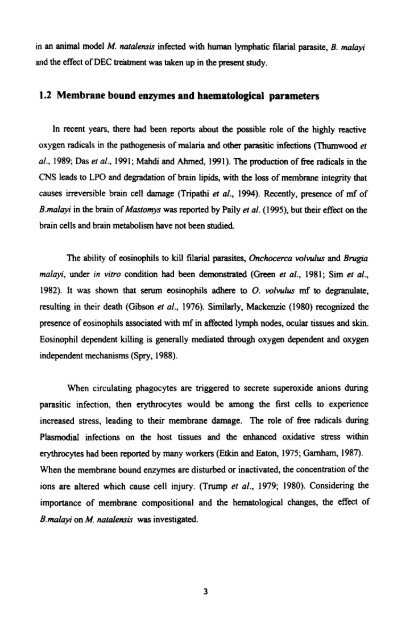effect of infection of the filarial parasite brugia malayi - Pondicherry ...
effect of infection of the filarial parasite brugia malayi - Pondicherry ...
effect of infection of the filarial parasite brugia malayi - Pondicherry ...
You also want an ePaper? Increase the reach of your titles
YUMPU automatically turns print PDFs into web optimized ePapers that Google loves.
in an animal model M. natalensis infected with human lymphatic <strong>filarial</strong> <strong>parasite</strong>, B. <strong>malayi</strong><br />
and <strong>the</strong> <strong>effect</strong> <strong>of</strong> DEC tr&bnent was taken up in <strong>the</strong> present study.<br />
1.2 Membrane bound enzymes and haematological parameters<br />
In recent years, <strong>the</strong>re had been reports about <strong>the</strong> possible role <strong>of</strong> <strong>the</strong> highly reactive<br />
oxygen radicals in <strong>the</strong> pathogenesis <strong>of</strong> malaria and o<strong>the</strong>r parasitic <strong>infection</strong>s (Thumwood er<br />
al., 1989; Das et al., 1991; Mahdi and Ahmed, 1991). The production <strong>of</strong> free radicals in <strong>the</strong><br />
CNS leads to LPO and degradation <strong>of</strong> brain lipids, with <strong>the</strong> loss <strong>of</strong> membrane integrity that<br />
causes irreversible brain cell damage (Tripathi et al., 1994). Recently, presence <strong>of</strong> mf <strong>of</strong><br />
B.mallyi in <strong>the</strong> brain <strong>of</strong> Mrrrtomys was reported by Paily el al. (1995), but <strong>the</strong>ir <strong>effect</strong> on <strong>the</strong><br />
brain cells and brain metabolism have not been studied.<br />
The ability <strong>of</strong> eosinophils to kill <strong>filarial</strong> <strong>parasite</strong>s, Onchocerca wlvulus and Brugia<br />
maluyi, under in vitro condition had been demonstrated (Green el al., 1981; Sim et a!.,<br />
1982). It was shown that serum eosinophils adhere to 0. wlvulus rnf to depulate,<br />
resulting in <strong>the</strong>ir death (Gibson et al., 1976). Similarly, Mackenzie (1980) recognized <strong>the</strong><br />
presence <strong>of</strong> eosinophils associated with mf in affected lymph nodes, ocular tissues and skin.<br />
Eosinophil dependent killing is generally mediated through oxygen dependent and oxygen<br />
independent mechanisms (Spry, 1988).<br />
When circulating phagocytes are triggered to secrete superoxide anions during<br />
parasitic <strong>infection</strong>. <strong>the</strong>n erythrocytes would be among <strong>the</strong> first cells to experience<br />
increased stress, leading to <strong>the</strong>ir membrane damage. The role <strong>of</strong> fke radicals during<br />
Plasmodia1 <strong>infection</strong>s on <strong>the</strong> host tissues and <strong>the</strong> enhanced oxidative stress within<br />
erythrocytes had been reported by many workers (Etkin and Eaton, 1975; Garnham, 1987).<br />
When <strong>the</strong> membrane bound enzymes are disturbed or inactivated, <strong>the</strong> concentration <strong>of</strong> <strong>the</strong><br />
ions are altered which cause cell injury. (Trump er al., 1979; 1980). Considering <strong>the</strong><br />
importance <strong>of</strong> membrane compositional and <strong>the</strong> hematological changes, <strong>the</strong> <strong>effect</strong> <strong>of</strong><br />
B.<strong>malayi</strong> on M. natalensis was investigated.

















